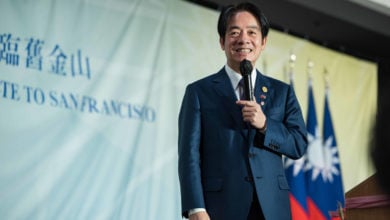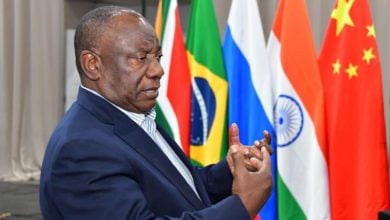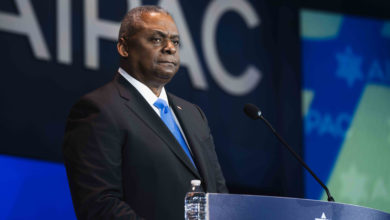 Imperialists unite to confront China. Here, Bush meets with Japanese Prime Minister Junichiro Koizumi. Tokyo, October 2003. Photo: Kevin Lamarque |
The declaration was a thinly veiled threat against China. The two imperialist powers are aiming to curb China’s growing military and economic influence in the region. It openly placed Taiwan under the U.S.-Japan defense umbrella.
The new declaration was an alteration of the 45-year-old U.S.-Japan Security Alliance. It was issued after a meeting of U.S. Secretary of State Condoleezza Rice, Defense Secretary Donald Rumsfeld, and their Japanese counterparts.
China issued an immediate rebuke. The People’s Daily, China’s official state newspaper, said, “the joint statement over the Taiwan question by the United States and Japan interferes severely with China’s internal affairs.”
In recent weeks, the U.S. has taken an increasingly aggressive stance towards the People’s Republic of China. High-ranking U.S. government officials have expressed alarm that the PRC’s growing strength may change the military balance between the U.S.-backed regime in Taiwan and the PRC. They have declared the PRC as a major U.S. concern and condemned it for alleged human rights abuses.
During his trip to Europe in February, President George Bush denounced the European Union’s intention to lift its 16-year-old arms embargo on the PRC, asserting that such a move would “change the balance of relations between China and Taiwan.” Senior members of the U.S. Congress from both capitalist parties warned the EU on March 1 that they would enact sanctions if the ban were lifted. (International Herald Tribune, March 3)
U.S.-China relations and the Cold War
The United States’ current relationship with the PRC is complex, but its goals are clear. On the one hand, the U.S. wants to use the PRC’s political influence to help secure regional objectives, like disarming and neutralizing North Korea. It seeks to maintain trade and other economic relations that benefit U.S. banks and corporations. U.S. exports to China grew by $33 billion in 2004.
However, the United States also wants to ensure it is not replaced by the PRC as the dominant influence in Asia. The United States wants to prevent China from becoming too powerful.
While the United States tries to maintain political and economic collaboration with the PRC, it remains hostile to the government. That is first and foremost because of the political leadership of the Communist Party of China. The U.S. treats the PRC much differently than it does capitalist countries, like France or Germany, when they disagree.
Eroding gains of the Chinese Revolution
With the socialist Chinese Revolution of 1949, the Chinese Communist Party led a social project that lifted millions of peasants and workers from dire poverty. Its leadership deprived the United States of the ability to exploit Chinese labor and markets after the defeat of its Japanese imperialist rival in World War II. Through years of arduous struggle and sacrifice, the Chinese people won many revolutionary social and economic gains.
Following the death of Mao Tse-tung in 1976, and the destruction of the pro-Mao faction of the CCP, the orientation of the Chinese government changed dramatically. Since the mid-1970s, the PRC began to integrate itself into the world capitalist economy. The Chinese Communist Party completely abandoned revolutionary internationalism as a guiding principle. China has joined the imperialist-run World Trade Organization; it sells arms to the racist state of Israel, and has soldiers stationed in Haiti as part of the UN occupying force.
Internally, class divisions are widening. Capitalist economic measures have produced a growing national bourgeoisie.
Forms of competition
To the extent it operates in the world capitalist economy, China competes and collaborates with the United States for markets. Its economy grew 9.5 percent last year, compared with 4.4 percent growth for the U.S. economy. China just surpassed the United States as Japan’s number one trading partner.
Although the PRC has increasingly allowed for the exploitation of its own labor force by foreign corporations, it has maintained enough independence to prevent it from becoming a neocolonial puppet nation. Its vast labor force and markets aren’t completely open for U.S. capitalist exploitation. Capital investment takes place in China only so long as it is tolerated by the state.
During the 1970s and 1980s, the United States built its ties with China on the basis of an anti-Soviet alliance. It was the central objective of U.S. foreign policy to divide the socialist bloc countries. The USSR, as the strongest economic and military pillar in the socialist bloc, was the target. When the USSR was overthrown by the counterrevolutionary upsurge in 1989 to 1991, the need for an anti-Soviet alliance was removed. U.S. imperialist policy towards China shifted.
The March 2 People’s Daily put it this way: “The United States is speeding up its actual plans for containment against China.” Containment was the foreign policy strategy pursued by the United States against the socialist camp after World War II.
Officially, it meant suppressing Soviet and Chinese influence in the world and dividing the worldwide communist movement where possible. The policy was backed up with nuclear threats and covert destabilization campaigns. In the 1950s alone, the United States threatened the PRC three times with nuclear war.
Referring to the U.S.-Japan joint agreement, the China Post said on March 2, “A new Cold War is taking shape.”
Taiwan has always been integral to the U.S. strategy to contain China. Over the past 56 years, the United States has used Taiwan as a way to maintain and extend its influence in the Asian-Pacific region. Washington uses Taiwan as a dagger aimed at the heart of the PRC.
Taiwan and U.S. imperialism
For centuries, Taiwan has been a province of China. It was colonized by the Dutch for a short period in the 1600s and later by the Japanese from 1895 to 1945.
The recent U.S.-Japan agreement caused justified outrage in light of the brutal history of Japanese colonialism in China. “Japan colonized Taiwan for half a century,” a Chinese analyst told the New York Times on Feb. 22. “When Japan talks about Taiwan, we think they have no right to talk.”
Between 1946 and 1949, the decade long civil war between the Communists and the Chinese Nationalist Party led by Chiang Kai-shek enveloped the country. The peasant-based rebellion led by Mao and the Chinese Communist Party finally resulted in victory in 1949. After the victory of the Chinese Revolution, Chiang Kai-shek fled to Taiwan with his counter-revolutionary army. The U.S. government backed Chiang’s occupation of the island province by threatening China with naval intervention. The United States refused to recognize the revolutionary government in Beijing, and took the position that Taiwan was part of China and Chiang was the leader of all China.
Meanwhile, Chiang’s warlord regime ruled the island, imposing martial law for decades. Taiwan essentially became a military garrison state for the United States. It was favored economically with capitalist investment and trade, quickly becoming one of the world’s main producers of plastics and, later, electronics.
The United States recognized Taiwan as China’s capital for the next 22 years, blocking the PRC’s entry into the United Nations. In 1971, the PRC finally took its rightful seat in the UN after a majority of member nations demanded it.
The U.S. government ultimately recognized the authority of the Communist Party over the whole of China for diplomatic purposes after the PRC rapprochement with U.S. imperialism in 1971. Since 1979, the U.S. government has recognized that Taiwan is a province of the PRC—known as the “one China” policy. This posture has allowed the United States to carry on commercial relations with Beijing.
Despite the stated policy, the U.S. ruling class and its policy strategists have fostered, supported and armed the pro-secessionist forces in Taiwan through the CIA and other intelligence agencies. Their puppets in Taiwan have tried for decades to break up the PRC by pushing for “independence.” What they’re really calling for is complete U.S. economic domination and control over the island. The United States wants Taiwan to remain in its sphere of influence to counterbalance China’s growth.
The pro-imperialist forces claim that the PRC is poised to invade the island militarily at any moment. But it is not the PRC that is the aggressor. The United States and its proxies are to blame.
The PRC has repeatedly stated that it does not want to use force to unify Taiwan with the mainland. It prefers to resolve outstanding disputes internally, without U.S. imperialist interference. This is the nature of the PRC’s proposed “anti-secession” law, which seeks peaceful reunification under the slogan “one country, two systems,” as it did with former British colonies Hong Kong and Macao in 1997 and 1999 respectively.
Reunification under this slogan would give the bourgeoisie in Taiwan the “right” to maintain private property and its vast fortunes. The properties of foreign capitalist corporations would also continue to belong to them.
One might believe imperialism would accept such a settlement. But the entire posture of the U.S. empire reveals an insatiable desire for total domination.
The PRC knows this well and has firmly stated that it is not afraid of confrontation if provoked. It recently announced it would boost military spending by 12.6 percent in 2005 to prevent any hostile move by Taiwan.
“We will continue to make our greatest efforts with the utmost sincerity to seek peaceful reunification. Meanwhile, we will never tolerate ‘Taiwan independence’ and never allow the secessionist forces to make Taiwan secede from the motherland under any name or by any means,” declared Chinese President Hu Jintao. (People’s Daily, March 4)
 Taiwan, colonized by Japan from 1895-1945, has been a province of China for centuries. Photo: Simon Kwong |
The United States and some of its imperialist allies are taking great pains to prevent China’s geopolitical ascension. This is the real reason behind the U.S.-Japan joint defense declaration.
Taiwan is only one component of the “plan.” In recent weeks, U.S. government officials have been publicly decrying the threat of Chinese military advancement and growth with the same goal in mind.
Undersecretary of Defense Douglas Feith, recently affirmed U.S. dissatisfaction with China’s current role in the world. Feith told the Council on Foreign Relations that China was one of the “four key concerns” of the United States. The other three are weapons of mass destruction, terrorism and failing states. (China Post, March 3)
The United States fears the PRC may pose a challenge to its long-term interests in the region. U.S. officials are concerned the growing PRC navy and modernized military will rival Washington’s in the future.
The PRC engages in arms trade with Russia to the tune of some $2 billion per year. Now the European Union wants to reopen arms trade with China. The United States is vehemently against it. Lifting the EU arms ban would increase the profits of its imperialist rivals while strengthening China militarily—two things the United States wants to avoid.
CIA director Porter Goss recently told the Senate Armed Services Committee, “Beijing’s military modernization and military buildup could tilt the balance of power in the Taiwan Strait. … Improved Chinese capabilities threaten United States forces in the region.” (New York Times, Feb. 19)
Chinese military modernization is not a direct threat to the people of the United States. The PRC’s military expenditures are a mere $30 billion, while the United States’ top $400 billion and Japan’s are more than $50 billion. The U.S. ruling class views China as a potential threat as it becomes a bigger world player.
U.S. policymakers have been concerned about China’s potential for several years. In 2002, the Bush administration threatened China and other would-be rivals with military aggression if they encroached on U.S. global military power.
The National Security Strategy of the United States of America declared that the United States would do all in its power to prevent the appearance of another “peer competitor” in the military realm and would not hesitate to engage in “preemptive” interventions to advance its national security interests. It was adopted as the official doctrine of U.S. foreign policy.
New alliances and self-defense
China is bolstering its position in the world with new trade and military alliances. The PRC has signed significant trade accords with current U.S. targets Russia, Iran, Sudan and Venezuela, among others. These pacts for oil, arms and other goods, have sparked worry within the U.S. ruling class.
Additionally, China and Russia announced in late 2004 that they would hold their first joint military exercise. The massive exercise will take place in China in August or September 2005 and involve hundreds of thousands of soldiers.
Despite its threats and bellicose language, the United States has maintained diplomatic relations with the PRC. This is partially for economic reasons. The U.S. knows that if it gets too belligerent, China can punish it by throwing U.S. manufacturers out of the market.
The United States ultimately aims to eradicate all of China’s socialist roots and return the country to a neocolonial vassal status.
The working people of the United States have nothing to fear from China’s modernization or the Chinese people’s determination to overcome a century of colonial humiliation. But the imperialist military-industrial complex is driving toward confrontation in the months and years ahead. China has the right to defend itself, its sovereignty, and its territorial integrity. Instead of succumbing to the chauvinist and racist campaign against China, all working class organizations in the United States need to prepare to show their opposition to this reckless and imperialist drive.






